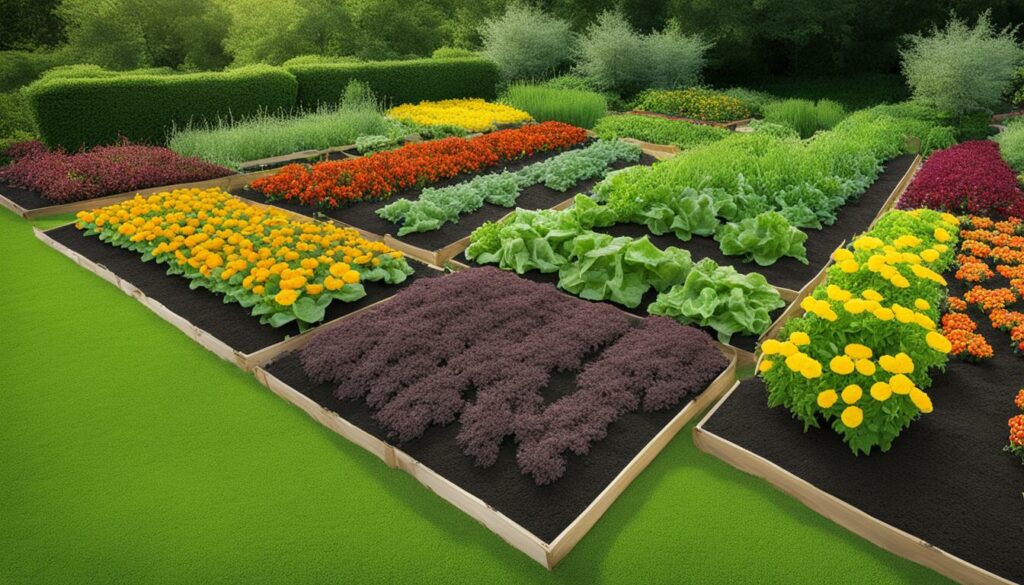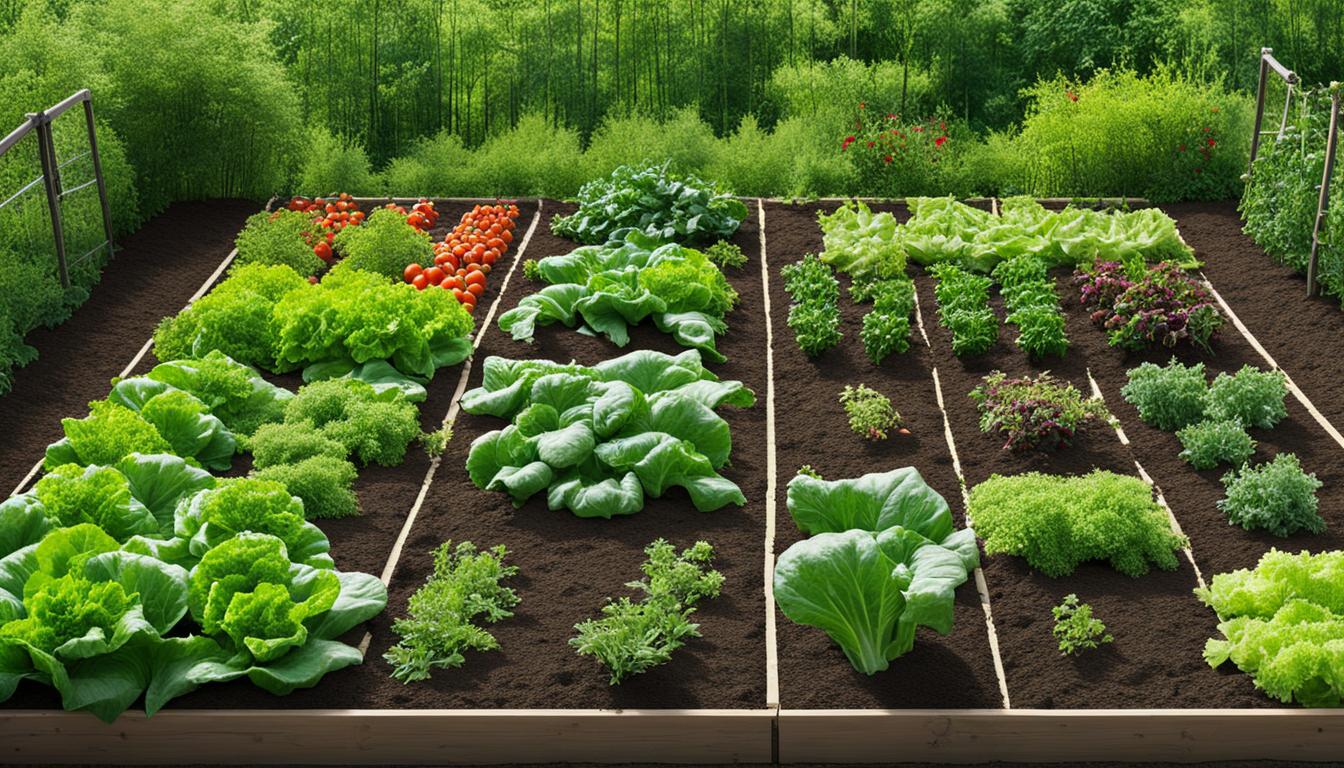Welcome to our comprehensive companion planting guide! In this article, we will explore the benefits of companion planting and provide you with a handy vegetable companion planting chart. Whether you’re a seasoned gardener or just starting out, this chart will help you select plant pairings that work harmoniously together to maximize your garden yield.
Companion planting is a popular gardening technique where different plants are grown together for mutual benefit. It’s like having a garden party where everyone brings something valuable to the table! By planting compatible combinations, you can deter pesky pests, improve soil fertility, attract beneficial insects, and suppress those stubborn weeds.
So, if you’re ready to take your gardening game to the next level, let’s dive into the wonderful world of companion planting with our vegetable companion planting chart as your trusty guide. Let’s get planting and watch your garden flourish!
Benefits of Companion Planting
Companion planting is not only a sustainable gardening technique but also offers various benefits for organic gardeners. By strategically pairing plants, gardeners can create a harmonious environment that enhances plant growth and deters pests naturally.
One of the key benefits of companion planting is the ability to utilize beneficial plant pairings. Some plants, such as marigolds, have insect-repellent properties and can help protect neighboring plants from pests. On the other hand, certain plants, like dill and fennel, attract beneficial insects such as ladybugs and lacewings, which prey on garden pests.
In addition to pest control, companion planting also improves plant compatibility and nutrient availability. For example, planting nitrogen-fixing plants like peas or beans alongside heavy feeders like tomatoes or peppers can provide a natural source of nitrogen for the latter plants. This not only reduces the need for synthetic fertilizers but also promotes healthier growth.
| Benefits of Companion Planting | Examples | |
|---|---|---|
| 1. Pest Control | – Marigolds repel aphids | – Dill attracts beneficial insects |
| 2. Plant Compatibility | – Nitrogen-fixing plants benefit heavy feeders | |
| 3. Nutrient Availability | – Legumes enhance soil fertility |
Furthermore, companion planting offers additional advantages like natural shade, trellis support, and weed suppression. Taller plants, such as corn or sunflowers, can provide shade for more delicate crops, reducing water evaporation and creating a microclimate. Climbing plants, like beans or cucumbers, can utilize the vertical space provided by trellises or cornstalks. This maximizes garden space and increases overall productivity.
So, whether you are a beginner or an experienced gardener, incorporating companion planting techniques into your organic gardening practices can lead to a more balanced and thriving garden ecosystem.
Popular Companion Planting Combinations
Companion planting involves strategically pairing plants to benefit each other and improve overall garden health. The vegetable companion planting chart suggests numerous combinations that work well together. By selecting compatible plant pairings, gardeners can create a thriving ecosystem that maximizes yield and minimizes pest problems.
One popular combination is planting basil with tomatoes and peppers. Basil acts as a natural pest deterrent, repelling insects like aphids and whiteflies that commonly affect these nightshade vegetables. Not only does basil help protect tomatoes and peppers from pests, but it also enhances their growth and flavor.
Beans are another versatile plant that can be grown alongside various vegetables. They can be paired with beets, corn, squash, strawberries, and sunflowers. Beans fix nitrogen in the soil, benefiting their companion plants by providing them with a nutrient boost. In return, plants like corn provide support for the climbing bean vines.
Carrots also have several compatible companions. They thrive when planted near chives, leeks, onions, peas, and radishes. Chives and onions repel carrot flies, while peas and radishes improve soil health and deter pests. This combination helps carrots grow more robustly and develop their characteristic sweet flavor.
| Vegetable | Companion Plants |
|---|---|
| Tomatoes | Basil, asparagus, borage, garlic, onions, parsley, thyme |
| Beans | Beets, corn, squash, strawberries, sunflowers |
| Carrots | Chives, leeks, onions, peas, radishes |
These popular companion planting combinations illustrate how different plants can support each other’s growth and deter pests. By incorporating these pairings into your garden, you can create a harmonious and productive environment for your vegetables.
Companion Planting for Specific Vegetables
When it comes to companion planting, each vegetable has its own unique preferences and combinations that can help promote optimal growth and health. By strategically selecting companion plants for specific vegetables, gardeners can create a thriving garden ecosystem. Here are some vegetable gardening tips and companion planting suggestions for popular vegetables.
Tomatoes:
Tomatoes thrive when planted alongside certain companion plants. Consider planting tomatoes with asparagus, basil, borage, garlic, onions, parsley, and thyme. These companion plants can help deter pests, improve soil fertility, and enhance the flavor of tomatoes.
Cucumbers:
Cucumbers benefit from being planted near specific companion plants. Consider planting cucumbers alongside beans, borage, dill, and lettuce. These companion plants can provide shade, attract beneficial insects, and improve overall plant health.
Onions:
Onions have beneficial pairings with several companion plants. Plant onions near beets, cabbage, carrots, lettuce, strawberries, and tomatoes to maximize their growth and health. These companion plants can help deter pests and improve soil fertility.
| Vegetable | Companion Plants |
|---|---|
| Tomatoes | Asparagus, basil, borage, garlic, onions, parsley, thyme |
| Cucumbers | Beans, borage, dill, lettuce |
| Onions | Beets, cabbage, carrots, lettuce, strawberries, tomatoes |
By following these vegetable gardening tips and companion planting recommendations, you can create a harmonious garden where each plant supports and enhances the growth of others. Experiment with different combinations to find what works best for your specific gardening conditions. Remember to observe recommended plant spacing and consider factors like sunlight, water requirements, and nutrient needs when planning your companion planting layout.
Companion Planting Herbs and Flowers

Companion planting techniques extend beyond just vegetables. Incorporating herbs and flowers into your garden can provide additional benefits and support the overall health of your plants. These natural allies can help deter pests, attract beneficial insects, and improve biodiversity.
The Power of Herbs
Herbs like basil, mint, oregano, and rosemary have long been known for their culinary benefits, but they can also play a crucial role in companion planting. These herbs possess insect-repellent properties, making them effective allies for nearby plants. The strong aromas emitted by these herbs can help repel pests such as aphids, moths, and beetles, reducing the damage they can cause.
Bringing in the Blooms
Flowers are not just a pretty addition to your garden; they can serve a purpose beyond aesthetics. Flowers such as marigolds, nasturtiums, and sunflowers are known for their pest-repellent characteristics. These vibrant blooms attract beneficial insects like ladybugs, lacewings, and hoverflies, which feed on common garden pests like aphids, thrips, and whiteflies.
Additionally, certain flowers can provide a natural form of shade for more delicate plants, helping to regulate soil temperatures and conserve moisture. This can be particularly beneficial during hot summer months when your garden may be at risk of drought stress.
Creating a Harmonious Garden
When incorporating herbs and flowers into your garden, consider interplanting them with your vegetables or creating dedicated beds or borders. This will allow for a harmonious mix of plants, attracting beneficial insects while adding visual interest and diversity to your garden. Remember to consider the specific needs of each plant when deciding on the placement and spacing.
By harnessing the power of herbs and flowers, you can boost your garden’s defenses against pests, attract beneficial insects, and create a more vibrant and thriving ecosystem.
Best Companion Plants for Annual Crops
When it comes to companion planting with annual crops, selecting the right combinations can greatly enhance the growth and productivity of your garden. By strategically pairing certain vegetables together, you can create a symbiotic relationship that benefits both plants. Here are some organic gardening tips to help you choose the best companion plants for your annual crops.
1. Beans: Beans are a versatile crop that can be grown alongside a variety of vegetables. They benefit from being planted near corn, cucumbers, lettuce, melons, potatoes, squash, and sunflowers. The beans help improve the soil by fixing nitrogen, while the other plants provide support, shade, and nutrient exchange.
2. Corn: Corn is another annual crop that can benefit from companion planting. It is often grown with beans, cucumbers, melons, peas, potatoes, and squash. The beans not only provide nitrogen but also climb up the corn stalks, allowing for vertical growth and efficient use of space. Meanwhile, the other plants offer shade, moisture retention, and pest control.
3. Lettuce: Lettuce grows well with a variety of companion plants. It can be paired with beets, carrots, cucumbers, onions, radishes, and strawberries. These combinations help maximize space, enhance soil fertility, and deter pests. For example, planting lettuce with onions can help repel aphids, while growing it with radishes can deter flea beetles.
When planning your garden, consider incorporating these companion planting combinations to create a thriving and productive space. Keep in mind the specific needs and preferences of each plant and experiment with different pairings to find what works best for your garden. By practicing companion planting with your annual crops, you can optimize the health and yield of your garden in an organic and sustainable way.
Table: Companion Plants for Annual Crops
| Annual Crop | Companion Plants |
|---|---|
| Beans | Corn, cucumbers, lettuce, melons, potatoes, squash, sunflowers |
| Corn | Beans, cucumbers, melons, peas, potatoes, squash |
| Lettuce | Beets, carrots, cucumbers, onions, radishes, strawberries |
Using Companion Planting for Disease and Pest Control
Companion planting is not just about enhancing the growth and health of plants—it can also be a powerful tool for natural disease and pest control in the garden. By strategically selecting plant combinations, gardeners can create a diverse and balanced ecosystem that discourages pests and reduces the risk of diseases spreading.
One example of companion planting for pest control is the use of marigolds with cabbage, broccoli, and cauliflower. Marigolds have properties that repel cabbage worms, a common pest that can damage these vegetable crops. Planting marigolds alongside these brassicas acts as a natural deterrent, protecting the plants from infestation.
Nasturtiums are another popular companion plant for pest control. When planted near brassicas like cabbage and kale, nasturtiums act as a trap crop for caterpillars. Caterpillars are attracted to the nasturtiums instead of the main vegetable crop, reducing damage and avoiding the need for chemical interventions.
By strategically using companion planting techniques for disease and pest control, gardeners can minimize the reliance on synthetic pesticides and promote a healthier and more sustainable garden environment.
Importance of Crop Rotation in Companion Planting
Crop rotation is a fundamental practice in companion planting that plays a vital role in maintaining the long-term health and productivity of your garden. By strategically rotating crops, gardeners can prevent the buildup of pests and diseases, as well as address nutrient imbalances within the soil. This ensures that your plants have the best possible conditions for growth and minimizes the need for chemical interventions.
One of the main benefits of crop rotation is its ability to break pest and disease cycles. Many pests and diseases have specific plant hosts they rely on for survival. By rotating crops, you disrupt the lifecycle of these pests and diseases, making it more challenging for them to establish and spread in your garden. This helps prevent the need for chemical pesticides and promotes a healthier and more sustainable garden ecosystem.
In addition to pest and disease control, crop rotation also helps maintain soil fertility. Different plants have varying nutrient requirements, and some plants can deplete specific nutrients from the soil while others replenish them. By rotating crops, you give the soil an opportunity to recover and restore its nutrient levels. This results in healthier plants with improved yields and reduces the need for artificial fertilizers.
| Crop Rotation Example | Benefits |
|---|---|
| Year 1: Planting tomatoes | Tomatoes are heavy feeders that deplete the soil of nutrients. |
| Year 2: Planting legumes (beans or peas) | Legumes fix nitrogen in the soil, improving fertility for future crops. |
| Year 3: Planting leafy greens (lettuce or spinach) | Leafy greens have shallow root systems and do not require excessive nutrients. |
When implementing crop rotation, it’s essential to plan your garden layout in advance and keep detailed records. Consider the specific nutrient needs of each crop and aim for a diversified crop rotation that includes different plant families. This not only helps maintain soil fertility but also reduces the risk of accumulated pests and diseases that affect specific plant families.
By incorporating crop rotation into your companion planting techniques, you can create a healthy and sustainable garden that thrives year after year. It’s an organic gardening tip that promotes soil health, minimizes pests and diseases, and ensures a bountiful harvest for seasons to come.
Gardening Techniques for Successful Companion Planting
Implementing companion planting techniques is key to creating a thriving and harmonious garden. By strategically selecting plant combinations and following proper gardening practices, you can maximize the benefits of companion planting. Here are some essential tips to help you succeed:
1. Consider Plant Spacing
When implementing companion planting, it’s important to consider the spacing requirements of each plant. While growing plants close together can encourage beneficial interactions, overcrowding can lead to competition for resources. Be sure to follow recommended plant spacing guidelines to ensure adequate airflow and sunlight for each plant.
2. Rotate Crops
To maintain soil health and prevent the buildup of pests and diseases, practice crop rotation in your garden. Avoid planting the same crop or crops from the same family in the same spot year after year. Instead, rotate your crops each season, preferably in a three to four-year cycle. This helps break pest and disease cycles and ensures that nutrients are evenly distributed throughout the garden.
3. Integrate Herbs and Flowers
Incorporating herbs and flowers into your vegetable garden can further enhance the benefits of companion planting. Herbs like basil, mint, and oregano have natural insect-repellent properties, while flowers such as marigolds and nasturtiums attract beneficial insects. Intersperse these plants among your vegetables or create borders to promote biodiversity and increase pollination.
“Companion planting is like creating a diverse community where each plant has a role to play and supports the overall health of the garden.”
By following these companion planting tips and techniques, you can create a resilient and productive garden ecosystem. Remember to experiment and adapt your approach based on your specific growing conditions and the needs of your plants. With a little patience and observation, you’ll discover the perfect combinations that will benefit your garden for years to come.

Three Sisters Planting Method
The Three Sisters planting method is a traditional Native American technique that brings together corn, pole beans, and squash in a mutually beneficial relationship. This companion planting practice is not only practical but also symbolizes the harmonious coexistence of these three crops.
In Three Sisters planting, corn serves as a support for the pole beans to climb. As the beans grow, they provide nitrogen to the soil, benefiting the nitrogen-loving corn. Meanwhile, the sprawling squash plants act as living mulch, shading the soil, reducing water evaporation, and suppressing weed growth. This natural mulch also helps to maintain soil moisture levels, enhancing the overall health and productivity of the three crops.
This planting method offers several advantages. Firstly, it maximizes the use of space, as the three crops are grown in proximity to each other. Secondly, it enhances soil fertility through the nitrogen fixation of beans and the soil-improving properties of squash. Finally, it provides a sustainable and efficient way of gardening, where the crops mutually support and protect each other, reducing the need for external inputs and interventions.
| Crop | Planting Tips |
|---|---|
| Corn | Plant corn in blocks or rows, spacing them about 12-18 inches apart. It is recommended to have at least four rows for proper pollination. |
| Pole Beans | Sow pole beans once the corn has reached a height of 6-8 inches. Plant the beans at the base of each cornstalk, allowing them to climb naturally. |
| Squash | Plant squash seeds or seedlings between the corn and bean rows, at a distance of about 18-24 inches from the corn. |
The Three Sisters planting method demonstrates the wisdom of nature and indigenous agricultural practices. By combining corn, pole beans, and squash, gardeners can create a harmonious and productive garden ecosystem, where each crop benefits from the presence of the others. This ancient technique not only yields healthy and abundant harvests but also serves as a powerful reminder of the interconnectedness of all living things.
Other Factors to Consider in Companion Planting
Companion planting involves more than just selecting compatible plants for your garden. It also requires consideration of various factors to ensure successful outcomes. When planning your companion planting strategy, keep in mind the following gardening techniques and tips:
1. Sunlight Requirements
Plants have different sunlight requirements, so it’s essential to pair those that have similar needs. For example, sun-loving plants like tomatoes and peppers should be placed in areas that receive full sun, while shade-tolerant plants like lettuce and spinach can be grown in partially shaded areas. By understanding the sunlight preferences of your plants, you can create harmonious companion plant pairings that thrive together.
2. Watering Needs
Watering is another crucial factor to consider when implementing companion planting techniques. Some plants require more frequent watering, while others prefer drier conditions. Matching plants with similar watering needs will help ensure that they receive the appropriate amount of moisture. This also prevents overwatering or underwatering certain plant varieties, leading to healthier growth and reduced risk of disease.
3. Nutrient Requirements
Understanding the nutrient requirements of companion plants is vital for maintaining overall garden health. Some plants are heavy feeders and require a nutrient-rich soil, while others have more modest nutrient needs. Pairing plants with complementary nutrient requirements can prevent nutrient imbalances and ensure optimal growth. Additionally, incorporating nitrogen-fixing plants like legumes into your companion planting strategy can help replenish soil fertility naturally.
“By considering factors such as sunlight, water, and nutrient needs, gardeners can create harmonious companion plant pairings that thrive together.”
By taking into account these gardening techniques and companion planting tips, you can enhance the success of your garden and optimize the benefits of companion planting. Experimentation and observation are key, as the best combinations may vary depending on your specific gardening conditions. So don’t be afraid to try new plant pairings and adjust your strategy based on the results. Happy companion planting!
Conclusion
Companion planting is a valuable technique in organic gardening that can greatly benefit your garden’s productivity and overall health. By referring to the vegetable companion planting chart and considering the various plant combinations, you can enhance the growth of your vegetables, deter pests, and improve soil fertility. This approach to gardening promotes a more sustainable and bountiful harvest, all while creating a balanced and thriving ecosystem.
Implementing companion planting techniques allows plants to work together, benefiting one another in multiple ways. Some plants repel pests, while others attract beneficial insects that help control garden pests. Certain combinations enhance nutrient availability and suppress weeds, while others provide natural shade and support. By carefully selecting compatible plants, you can optimize your garden’s potential.
Remember, companion planting is not just about science, but also about observation and experimentation. It’s important to consider factors such as sunlight, water requirements, and nutrient needs when selecting plant pairings. As you explore different combinations, you’ll discover what works best for your specific gardening conditions. Utilize the vegetable companion planting chart as a helpful guide and let your garden flourish with the power of companion planting!
FAQ
What is companion planting?
Companion planting is a gardening technique where different plants are grown together for mutual benefit.
What are the benefits of companion planting?
Companion planting offers benefits such as pest deterrence, improved soil fertility, attracting beneficial insects, and weed suppression.
Where can I find a vegetable companion planting chart?
You can find a vegetable companion planting chart online or in gardening resources.
What are some popular companion planting combinations?
Popular companion planting combinations include basil with tomatoes and peppers, and beans with beets, corn, squash, strawberries, and sunflowers.
How can I use companion planting for specific vegetables?
The vegetable companion planting chart provides recommendations for specific vegetables, such as planting cucumbers near beans, borage, dill, and lettuce.
Can I use herbs and flowers for companion planting?
Yes, herbs like basil, mint, oregano, and rosemary, as well as flowers like marigolds, nasturtiums, and sunflowers, can be used for companion planting.
Which companion plants are best for annual crops?
For annual crops, beans benefit from being grown near corn, cucumbers, lettuce, melons, potatoes, squash, and sunflowers.
Can companion planting help control diseases and pests?
Yes, strategic plant combinations can help control diseases and pests naturally by disrupting their lifecycle and reducing their population.
Why is crop rotation important in companion planting?
Crop rotation helps prevent disease and nutrient imbalances by avoiding planting the same crop in the same spot consecutively.
How can I implement companion planting techniques effectively?
To implement companion planting techniques effectively, consider the spacing requirements of companion plants and follow proper crop rotation practices.
What is the Three Sisters planting method?
The Three Sisters planting method involves planting corn, pole beans, and squash together, creating a beneficial symbiotic relationship.
What factors should I consider in companion planting?
Factors to consider in companion planting include sunlight, water requirements, and nutrient needs of plants.

